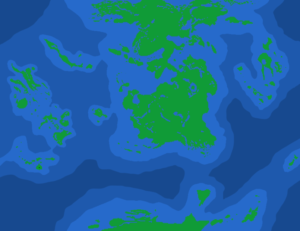
“Oh, Laksha, celestial masterpiece sculpted by hands unseen! Within your enchanting embrace, one is compelled to release the constraints of common worries and surrender to the allure of the infinite. For in your ethereal depths, where giants roam and nature’s symphony resounds, the mortal spirit finds respite, nourished by the sheer magnificence of a world suspended between dream and reality.”
– Deya’eraja, a Bea’viskarian poet.
The tropical planet, Laksha, stands out in the vast expanse of the known galaxy due to its unparalleled biodiversity. This can be attributed to a fascinating quirk that endows it with both a rich, dense atmosphere and remarkably low gravity. The planet’s atmosphere is abundant in life-sustaining oxygen and permeated with a thick veil of moisture and spores, creating an otherworldly environment.
On Laksha, one cannot help but marvel at the breathtaking sight of vast tropical forests stretching as far as the eye can see. Towering trees, reaching out towards the sunlight, dominate the landscape, their canopies forming a magnificent tapestry of greenery. The seas surrounding the landmasses are shallow and studded with numerous volcanic islands, adding to the planet’s enchanting allure.
But it is the awe-inspiring fauna of Laksha that truly captivates visitors and researchers alike. The planet is home to an array of extraordinary creatures, each more remarkable than the last. Colossal herbivores, their sheer size causing the ground to tremble with each step, roam the land, peacefully grazing on the abundant vegetation. Meanwhile, predatory beasts possess an astounding agility that belies their immense proportions, allowing them to capture their prey with surprising ease.
The abundance of spores and organic macro-particles in Laksha’s atmosphere contributes to a unique phenomenon—an ethereal haze envelops the planet, obscuring distant vistas and infusing the environment with an air of mystique. This limited visibility has played a pivotal role in shaping the evolution of the planet’s giant animals. Over time, they have developed specialized sensory organs to effectively navigate their surroundings. Some creatures have honed their hearing to an extraordinary degree, while others possess a keen sense of smell, enabling them to thrive in this captivating but challenging habitat.
Scattered across the planet are also remnants of a bygone civilization – massive artificial structures that jut skywards from a carpet of green. The ruins, now covered in vegetation and intertwined with the natural world, provide a stark contrast to the vibrant life that flourishes around them.
Their purpose remains a subject of speculation, with theories ranging from religious monuments to advanced scientific facilities. The deteriorating state of the ruins suggests that they have endured the test of time, standing as silent witnesses to the passage of millennia.
Geography

Laksha is a predominantly tropical world characterized by vast oceans, dense vegetation, and an exceptionally humid atmosphere. Despite the overwhelming presence of water, three major continents and numerous islands host diverse ecosystems. The planet’s climatic and geological features vary significantly, from the driest regions to the densest forests, and from extensive plains to towering mountain ranges.
Continents
1. Thand Ga (Southern Continent)
Thand Ga, located at the planet’s South Pole, is one of the driest regions on Laksha. Despite its arid conditions, it boasts numerous water features such as lakes and rivers, fed by the melting of seasonal ice and glacial formations. The landscape is dominated by taiga, the only biome of its kind on the planet. The flora and fauna here are adapted to the harsh, cold environment, with unique species that thrive in the continent’s limited resources.
2. Beehka Ga (Equatorial Continent)
Beehka Ga is a lush, vibrant land situated along Laksha’s equator. This continent is renowned for its abundant freshwater resources and dense, sprawling rainforests. The constant humidity and warm temperatures create an ideal environment for a vast array of plant and animal life. Geologically active, Beehka Ga is a continent on the move; it originally broke off from Thand Ga and has since collided with the northern continent, forming the planet’s most significant mountain range at their intersection. These mountains are not only the highest but also pose a formidable barrier to traversing between the two continents, resulting in limited ecological interchange.
3. Bara Ga (Northern Continent)
Bara Ga, the northernmost continent, is home to the planet’s largest plains. These expansive grasslands support a wide variety of herbivores and predators, creating a rich and balanced ecosystem. The high mountain ranges to its south further contribute to its diverse geography. The northern reaches of Bara Ga experience milder climates compared to the extreme cold of Thand Ga and the intense humidity of Beehka Ga.
Islands and Archipelagos
Scattered across Laksha’s oceans are numerous islands and archipelagos, each harboring unique ecosystems. These islands range from tropical paradises with coral reefs and diverse marine life to volcanic islands with rugged terrain and specialized flora and fauna. The isolation of these islands has led to the evolution of many endemic species, making them hotspots for biodiversity.
Climate and Weather Patterns
Laksha’s climate is dominated by its vast oceans, leading to high humidity levels across the globe. The equatorial region, encompassing Beehka Ga, experiences heavy rainfall and consistently warm temperatures, fostering lush rainforests. In contrast, Thand Ga, remains arid and cold year-round with brief, less severe summers. Bara Ga enjoys a variety of climates, from temperate zones in its central plains to colder regions closer to its mountain ranges.
This entry was made by the Lore Master. Map by Dysfunctional Dragonborn.